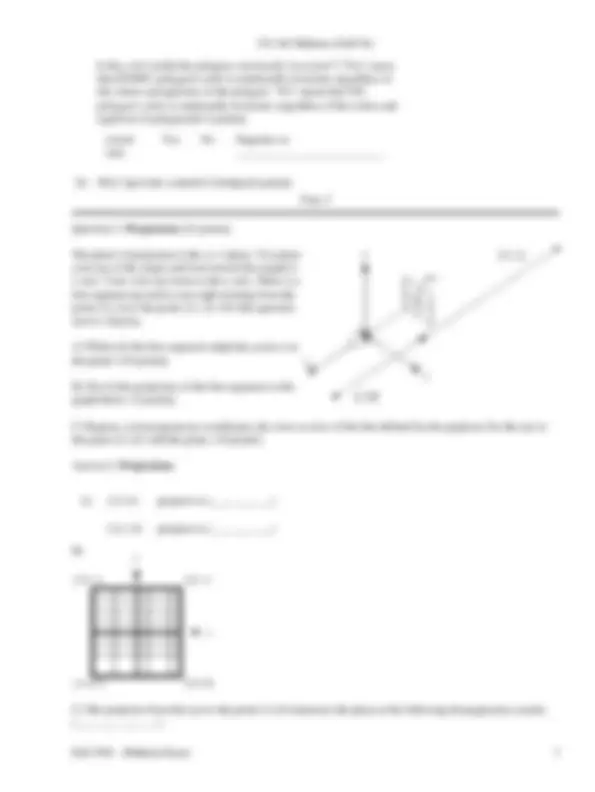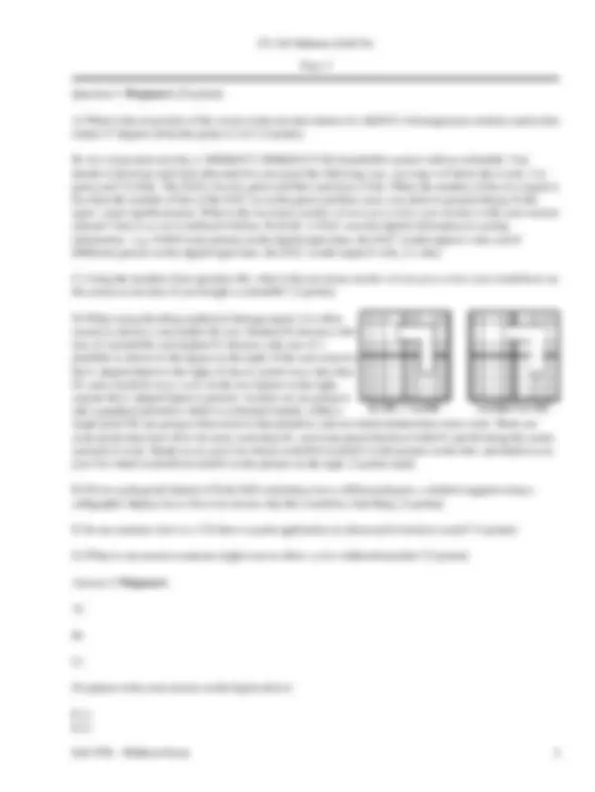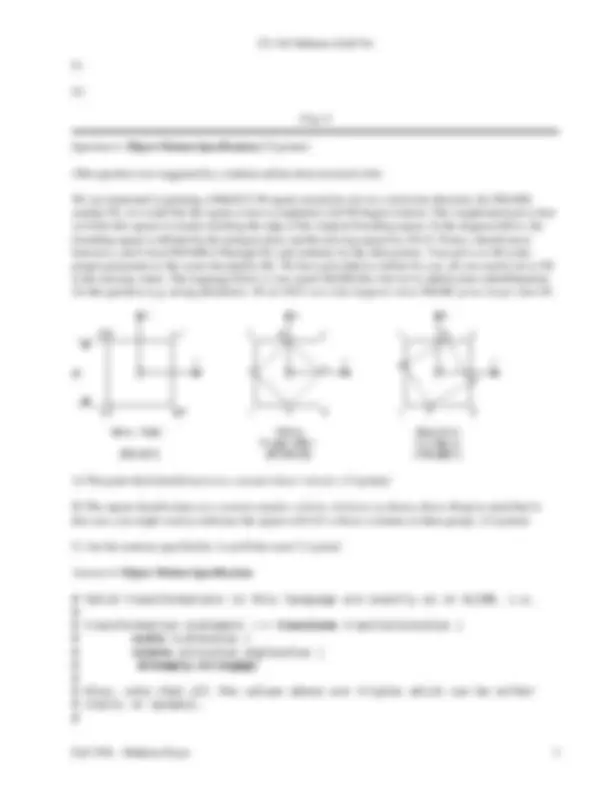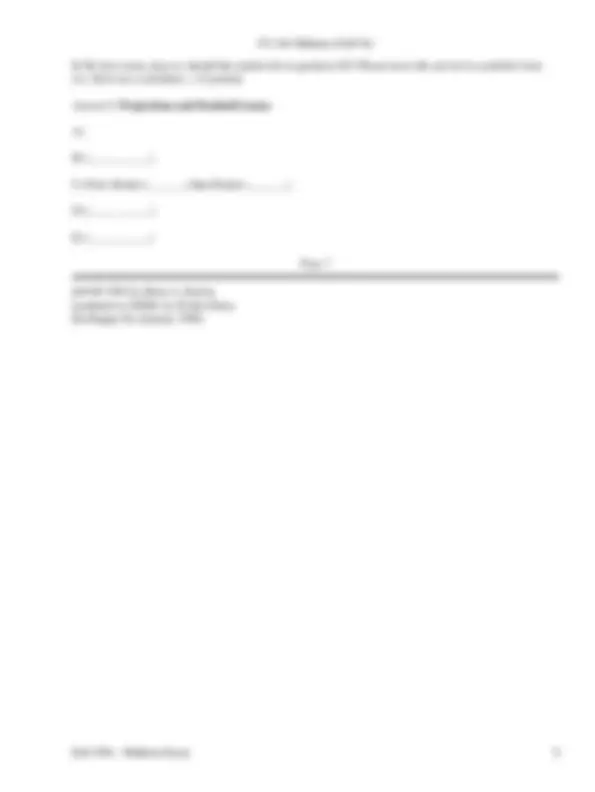






Study with the several resources on Docsity

Earn points by helping other students or get them with a premium plan


Prepare for your exams
Study with the several resources on Docsity

Earn points to download
Earn points by helping other students or get them with a premium plan
Community
Ask the community for help and clear up your study doubts
Discover the best universities in your country according to Docsity users
Free resources
Download our free guides on studying techniques, anxiety management strategies, and thesis advice from Docsity tutors
Main points of this exam paper are: Unit Cube, Scan Conversion, Area Represents, Grey Area, Distinct Regions, Two Edges, Concern Rotational, Rotational Invariance, Arbitrary Rotation, Homogeneous Coordinates
Typology: Exams
1 / 8

This page cannot be seen from the preview
Don't miss anything!





College of Engineering Department of Electrical Engineering and Computer Sciences Computer Science Division
Professor Brian A Barksy TAs: Dan Garcia and Zijiang Yang
Relax. You have 80 minutes. You will be graded on the best 4 out of 5 problems. This means you should allocate about 16 minutes per question. Remember to pace yourself. Feel free to use the back of each page for additional answer space. Do not panic. You will have time.
GOOD SKILL
Page 1
Question 1: Scan Conversion [25 points]
In the figure to the right, the grey area represents a dense concentration of edges of a very degenerate polygon. You cannot tell how many edges there are within that region, nor the direction of them. There are two edges we are sure of - these are labeled in bold with the directions specified. There are two topologically distinct regions we care about, X and Y. Each of A-D is worth 3 points for a correct answer, - point for a wrong answer, and 0 points if left blank. This is so that a random guessing strategy will, on average, yield 0 overall points. In the future, this will be written [3/-1 points] to indicate the value of a correct/incorrect answer, and will be used for multiple-choice questions.
Computer Science 184 - Foundations of Computer Graphics 1
A) For the Odd/Even rule, is X : (circle one)
IN OUT depends-what's-in-the-grey-region
B) For the Non-Zero-Winding rule, is X : (circle one)
IN OUT depends-what's-in-the-grey-region
C) For the Odd/Even rule, is Y : (circle one)
IN OUT depends-what's-in-the-grey-region
D) For the Non-Zero-Winding rule, is Y : (circle one)
IN OUT depends-what's-in-the-grey-region
Questions E-G concern rotational invariance (i.e. does the category in question remain constant after an arbitrary rotation)
E) Is region classification (i.e. whether a region is in or out) by the Non-Zero-Winding rule rotationally invariant? [3/-1 points]
(circle one)
Yes No Depends on
F) We specify the color (R,G,B) for every corner of a polygon (as in one of you assignments). We are then given an ideal system in which each pixel is infinitely small (thus we don't have to worry about all of the nitpicky details that arise due to corners falling between scanlines like special cases for convex corners, incrementing the attributes by that additional wierd factor when first added to the edge_y_start list, etc.). We then color the inside of the polygon using a linear interpolation ("lerping") strategy exactly as in your handout. Think very carefully of different types of polygons and the colors that could be chosen when you answer this question.
Page 3
Question 3: Potpourri [25 points]
A) What is the magnitude of the vector in the second column of a 4× 4 homogeneous rotation matrix that rotates 57 degrees about the point (1,3,4)? [3 points]
B) At a swap meet you buy a 1000× 1000× 9 bit framebuffer system with no colortable. You decide to bread up each byte allocated for your pixel the following way: you map 4 of those bits to red, 3 to green and 2 to blue. The DACs for red, green and blue each have 4 bits. When the number of bits of a signal is less than the number of bits of the DAC (as in the green and blue case), you short to ground (binary 0) the upper , most significant pins. What is the maximum number of non-grey-colors you can have with your current scheme? Grey is as we've defined it before, R=G=B. A DAC converts digital information to analog information - e.g. if 0010 were present on the digital input lines, the DAC would output 6 volts, and if 0000were present on the digital input lines, the DAC would output 0 volts. [3 volts]
C) Using the numbers from question (B), what is the maximum number of non-grey-colors you would have on the screen at one time if you bought a colortable? [3 points]
D) When using the tiling method of damage repair, it is often crucial to choose a reasonable tile size. Student #4 chooses a tile size of 4 pixels/tile and student #1 chooses a tile size of 1 pixel/tile as shown in the figures to the right. If the user removes the L-shaped object to the right, #1 has to search more tiles than #4, and overall do more work. In the two figures to the right, assume the L-shaped figure is present. Assume we are going to add a graphical primitive which is contained entirely within a single pixel We are going to then remove that primitive and see which student does more work. There are some pixels that force #4 to do more work than #1, and some pizesl that have both #1 and #4 doing the samm amound of work. Shade in any pixel for which work(#4)>work(#1) in the picture on the left, and shade in any pixel for which work(#4)>work(#1) in the picture on the right. [3 points each]
E) Given a polygonal dataset of Soda Hall containing over a million polygons, a student suggests using a calligraphic display for it. Give two resons why this would be a bad thing. [4 points]
F) In one sentence, how is a 2-D draw or paint application (as discussed in lecture) modal? [3 points]
G) What is one reasion someone might want to allow cycles within hierarchies? [3 points]
Answer 3: Potpourri
A)
D) (please write your answer on the figure above)
Page 4
Question 4: Object Motion Specification [25 points]
(This question was suggested by a student and has been tweaked a bit)
We are interested in spinning a 90× 90 square around its azis in a clockwise direction. By FRAME number 90, we would like the square to have completed a full 90 degree rotation. The complicated part is that we'd like the square to remain touching the edge of the original bounding square. In the diagram below, the bounding square is defined by the polygon abcd, and the moving square by a'b'c'd'. Point a' should move between a and b from FRAMEs 0 through 90, and similarly for the other points. Your job is to fill in the proper parameters to the scene description file. We have provided an outline for you, all you need to do is fill in the missing values. The language below is very much GLIDE-like, but we've added some embellishments for this quesiton (e.g. strong identifiers). We do NOT care what happens when FRAME grows larger than 90.
A) The point abcd should move at a constant linear velocity. [12 points]
B) The square should rotate at a constant angular velocity clockwise as shown above. Keep in mind that in this case, you might want to reference the square (a'b'c'd') without a rotation in other groups. [12 points]
C) Are the motions specified by A and B the same? [1 point]
Answer 4: Object Motion Specification
endinst endinst endgroup endgroup
group ourworld_group group ourworld_group instance abcd_group instance abcd_group endinst endinst instance abcd'_group instance abcd'_group endinst endinst endgroup endgroup
render ourworld_group render ourworld_group
Page 6
Question 5: Projections and Football Games [25 points]
Cal decides to add TV coverage to their football games. Every once in a while the camera will turn to the crowd and focus on a prticular fan, and the smiling fan will appear on the huge outdoor screen. Most of the time the fan will not be able to figure out from looking at the image of themselves on the big screen where the camera is. Your job is to figure this out given a particular example. You may make the assumption that the camera's view plane normal is parallel to its direction of projection).
Your head can be modeled as a unit cube centered at the origin. You ar looking directly down the positive z axis. We've labeled the back face of your head - the lower-left point is a, and b, c and d follow clockwise around the back of your head. Assume that the camera is in a blimp and has a very powerful lens - it is very very far away.
A) What classification of projection is it? Please be as specific as possible. (e.g. Perspective->Seven Point->Spamographic->etc.) [3 points]
B) Where is the camera? (i.e. What is its COP / DOP as it would have been specified in a descriptor file, e.g. Glide) [3 points]
C) If you were to rotate your head to face the camera about two fo the orthogonal axes, what two axes and
angles would you rotate around? e.g. Rotate(axis[either x, y, or z], ) [8 points]
D) What single axis would lyou rotate about to get the same effective rotation so that you were facing the camera? (ignoring twist - i.e. your final vuv might not be the same, but don't worry about that.). Your answer should be expressed as a single axis. (Hint: that axis will probably not be one of the orthoganol axes) [ points]
E) By how many degrees should the rotation be in question (D)? Please leave the answer in symbolic form. (i.e. don't use a calculator...) [5 points]
Answer 5: Projections and Football Games
A)
B) (___, ___, ___)
C) First: Rotate (___, ) then Rotate (, ___)
D) (___, ___, ___)
Page 7
© 1994 by Brian A. Barsky translated to HTML by Walter Hsiao Eta Kappa Nu (January 1996)